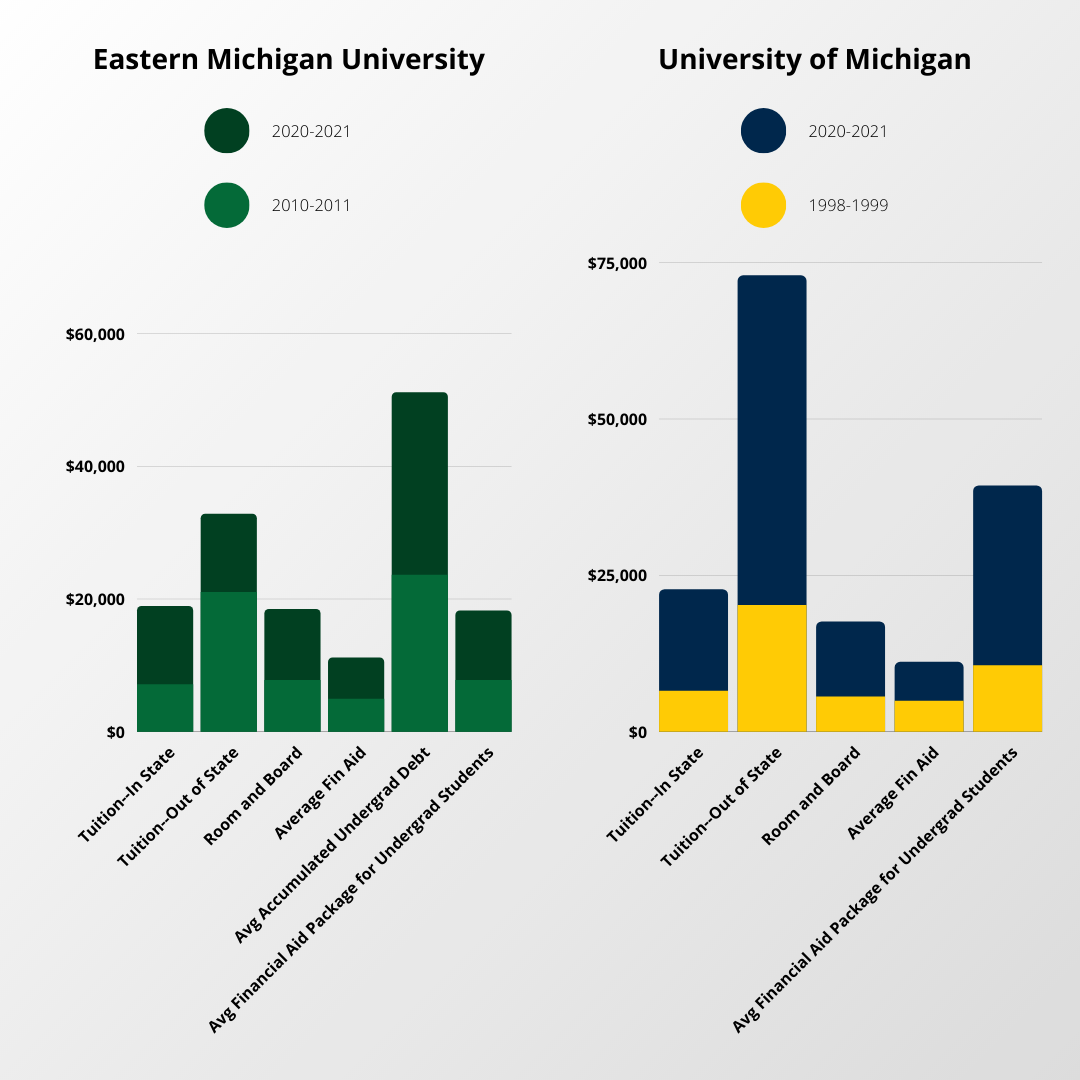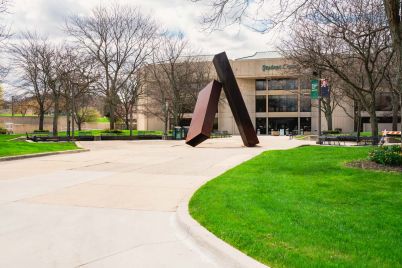
Torrence Williams | Washtenaw Voice
By CYDNEY HEED
Staff Writer
In an era of stagnating wages, skyrocketing student debt, and pandemic-induced mass layoffs, many students are weighing the true value of a degree.
Two four-year schools — University of Michigan and Eastern Michigan University — cite declines in state funding as the main reason that tuition is rising so quickly in comparison to both wages and inflation.
How much does it cost?
According to the National Center for Education Statistics, the average tuition at a four-year public institution in the 2001-2002 academic year was $12,805. By the 2017-2018 school year, that had risen to $20,050.
According to U of M’s Common Data Set, in 1998, yearly in-state tuition for undergraduate students at University of Michigan’s Ann Arbor campus was $6,550. In the 2019-2020 school year, it had more than doubled to $16,212.
To put that in perspective, $1 in 1998 would be equal to $1.56 in 2019, according to the Bureau of Labor Statistics. If U of M’s tuition had risen at the same rate as inflation, it would be $10,270.
EMU’s Common Data Set tells a similar story: in the 2010-2011 school year, in-state tuition for undergraduate students was $7,148. By 2019-2020, it had risen to $11,778.
Geoff Larcom, the executive director media relations at EMU, said “EMU’s average annual tuition and fees increase over the past decade is 3.9%.”
While U of M charges higher tuition rates for out-of-state students, EMU has recently begun charging the same rates to both in-state and out-of-state students, according to Larcom.
On top of tuition, students have to consider other costs.
U of M’s Common Data Set lists room and board costs for 2019-2020 at $11,996, up from $5,614 in 1998-1999.
EMU’s Common Data Set shows that room and board rose from $7,785 in 2010-2011 to $10,696 in 2019-2020.

Where do tuition dollars go?
At both U of M and EMU, tuition dollars go into the general fund, which also includes money from state appropriations, among other sources.
According to U of M’s website, the general fund pays for things like instruction, financial aid, academic advising, and libraries, among other things. It does not pay for athletic, housing, student publications, the Michigan Medicine Health System, or most construction projects.
According to the “General Fund Snapshot” on U of M’s website, labor accounts for about 63% of total costs. Costs related to academics account for the largest portion of general fund spending — about 67%.
The next largest portion is “executive officer and service units,” which account for about 13.7% of the general fund. About 0.8% of that portion of the budget went to the president — or $2.47 million.
U of M’s 20-21 Salary Disclosure report listed President Mark Schlissel’s salary at $810,000 yearly, down from $900,000 the previous year.
U of M froze faculty salaries for the 2020-2021 school year, and executive salaries have reportedly been cut in an effort to trim costs in light of the COVID-19 pandemic.
“We’ve also put in lots of cost-saving measures for this year. Faculty and staff are getting pay decreases. We’ve cut out all spending on travel and conferences. Discretionary spending has been trimmed for the year,” said Rick Fitzgerald, the assistant vice president for public affairs at U of M.
According to Fitzgerald, endowments have helped prevent tuition from rising even more.
According to an article written by Larcom for EMU Today, “The EMU Board of Regents approved a general fund budget of $288 million in revenues and corresponding expenses for the 2020-21 fiscal year. The budget represents a reduction of $5.5 million from the 2019-20 budget, which was $17.1 million less than the 2018-19 general fund budget.”
EMU’s athletics do receive some money from their general fund.
“Athletics does get support from the general fund, but that really forms a small portion of what tuition does,” said Larcom. “This is different from say a Power 5 school like U of M where the football program supports a lot of other sports and is self-funding.”
According to another article written by Larcom for EMU Today, President James M. Smith’s salary was raised to $455,000 in 2019.
EMU has also reduced pay for some faculty and administrators in light of the pandemic.
State funding
The biggest factor cited by both U of M and EMU as prompting tuition increases is a decline in state funding.
Both Fitzgerald and Larcom noted that state appropriations used to account for a much larger portion of the two school’s general funds than they do today.
“If you go back to when I was in college in the ‘70s, state funding provided as much as almost 60 to 70% of the university’s general fund,” Fitzgerald said, “And now tuition is providing that level of support for the general fund. State funding and tuition have traded places as the main source of revenue for the university’s academic mission.”
According to Fitzgerald, in 2020, state appropriations account for about 14% of the general fund.
In 2001, U of M received $363.5 million in state appropriations. During the 2019-2020 academic year, it received $ 322.7 million.
If funding had kept pace with inflation, U of M would have received about $567 million for the 19-20 school year.
Between the 2001-2002 school year and 2010-2011, total appropriations for higher education in Michigan decreased from about $1.6 billion to $1.4 billion.
“The first year of Rick Snyder’s Administration, there was a 15 percent across-the-board cut in state funding, and we’re still lagging behind,” Fitzgerald said.
EMU received $77.5 million for the 19-20 academic year, down from $87.6 million for the 2001-2002 academic year.
With the economic struggles brought on by the COVID-19 pandemic, it seems likely that Michigan will have to enact budget cuts at some point. How those cuts will affect higher education remains to be seen.
“The state kept all of the state appropriations the same for this year using by leveraging some of the CARES Act funding that went to the state,” Fitzgerald said. “What we don’t know is what next year will bring because the state won’t have that federal CARES funding. And we also know that because of the pandemic, state tax revenue has been negatively affected.”
Financial aid
Both schools noted that increases in need-based financial aid are offsetting tuition hikes for many students.
In the ‘98-99 academic year, the average need-based financial aid package at U of M was $10,631. In ‘19-20, it was $28,711.
In the 2010-2011 academic year, the average need-based financial aid package for undergraduate students at EMU was $7,785. In the ‘19-20 academic year, it was $10,477.
“Eastern Michigan recently passed a financial aid package for the ‘21-22 academic year of $53.3 million,” Larcom said. “And the great percentage of Eastern Michigan University’s student body is on some sort of financial aid. Over the last dozen years, Eastern Michigan has more than doubled its student financial aid, reflecting a central mission of supporting students in their academic success.”
U of M received praise in recent years for instituting the Go Blue Guarantee, which promises free tuition for families making less than $65,000 a year.
According to Fitzgerald, increases in financial aid have helped to offset tuition hikes for in-state students.
“For, I think, 11 years in a row, the increase in financial aid offset all of the increase in tuition for in-state students with financial need,” Fitzgerald said. “This year tuition went up 1.8% and financial aid increased by 5.6%.”
However, for many students, financial aid is not a perfect solution.
“My financial aid got completely messed up. So I had to pay for it. I only took one class this semester because of that. I paid for it all out of pocket. So that was a big surprise,” said Olivia Habart, who recently transferred from WCC to U of M.
Habart has been trying to figure out whether she qualifies for the Go Blue Guarantee, but at the time of her interview, she had not received an answer.
“So when you go to the financial aid website for U of M, they don’t really give you a lot of information about how you qualify. They say like, you know, your parents have to make $65,000 a year or less. Then you have to have $50,000 or less in assets,” Habart said.
Habart continued, “They leave out a lot of really important details, you know, like for example, if your parents own a home, you’re most likely not qualified for it. Also if you make any money, you’re also not qualified for it because most likely your income will be combined with your parents income to take both of them into account.”
According to an explanation on U of M’s website, “We define income as the total of student and parent wages, earnings from a business or other self-employment, other taxable income such as unemployment compensation, and all untaxed income.”
Regarding assets, U of M’s website says, “We consider total net worth, which includes: home equity, savings/checking, investments, real estate and business net worth, but not retirement accounts.”
FAFSA requires that both students and parent incomes be reported until the student turns 24, regardless of whether the student is self-sufficient or paying their own way through college.
Is it worth it?
According to the Federal Reserve of St. Louis, the median income in 2010 was $57,904. In 1998, it was $61,128. In 2019, it was $68,703.
Although wages increased at a markedly higher rate from 2018 to 2019, it remains to be seen how the COVID-19 pandemic will affect the median wage in 2020.
According to a 2018 Forbes article, between 1989 and 2016, college tuition increased eight times as much each year on average compared to the median income. Tuition increased by an average of 2.6% each year. Wages increased by 0.3%.
Despite these statistics, Fitzgerald points to a 2013 study titled “An Economist’s Perspective on Student Loans in the United States” by U of M’s Susan Dynarski: “To preview, I argue that there is no debt crisis: student debt levels are not large relative to the estimated payoff to a college education in the US. Rather, there is a repayment crisis, with student loans paid when borrowers’ earnings are lowest and most variable.”
To paraphrase: the issue isn’t the debt itself, it’s that people might struggle to pay their loans early on in their career when they aren’t making as much money.
Nonetheless, the sheer dollar amounts involved is still proving to be a barrier for some students.
“When I was in high school, I didn’t even apply to any four-year colleges because I knew I wouldn’t be able to afford it at the time,” Habart said. “So I think yeah, it definitely was a barrier because you know, I would have loved to apply straight out of high school, but knew I couldn’t afford it.”
In ‘98-99, the average accumulated student loans for an undergraduate student at U of M were $13,842. In 19-20, it was $27,224.
Eastern’s average accumulated debt rose from $23,669 in 2010-2011 to $27,475 in 2019-2020.
While Habart plans to continue her education at U of M, she does worry that she will wind up taking on more debt than she’d like.
“But one of my biggest goals, and one of the reasons I went to Washtenaw Community College, was to not have any student loan debt because I’m, you know, really interested in business and would ultimately like to start my own company. And if I already have like $50,000 in debt, I don’t want to take out more loans on top of that to start a business,” Habart said.
Habart did say that she’s found many of the resources available to her at U of M to be valuable.
She said, “You know, in only one semester at U of M I’ve gotten just as much help and assistance and like help with finding jobs as one year at Washtenaw Community College. So I do think it’s worth it if you have the time to take advantage of the resources.”
Habart also noted that it may be more difficult for lower-income students to take full advantage of the resources offered at U of M, saying, “They don’t have to work one or even two jobs in college. Like they can take advantage of all the clubs and they can go meet with you know, the career center and they can get involved and all these other extracurricular programs.”
“For low income student, they might not have a chance to do that because they have to work just be able to afford food and a place to stay. So I think that’s an important factor, too,” Habart continued.
Ultimately, many students are finding that there are no easy answers when it comes to affording college.
Some may feel comfortable with the promise of financial aid and the prospect of being able to earn more money over their lifetime. Others may decide to forego a 4-year degree due to cost of attendance and wage stagnation.
The indisputable fact is that tuition is rising, and it is doing so much more quickly than inflation or wages. No doubt, colleges will have to continue to find ways to make the numbers work for their students.
Part 2: Decline in state appropriations seen as key to tuition increases.


